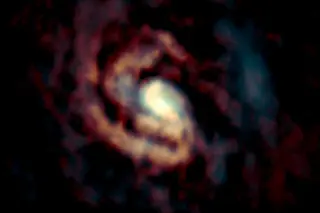Where once were donuts, now there may be fountains. Not literally, unfortunately, but new astronomical observations are rewriting scientists’ conceptions of what the area around a black hole looks like, and the new evidence seems to lean heavily away from the morning delicacy.
Scientists estimate that most galaxies have a supermassive black hole at their center, pulling in everything around them with tremendous gravitational forces. Up until now, astronomers believed that before material falls into a black hole it builds up into a structure that looks something like a cosmic donut.
Takuma Izumi, a researcher at the National Astronomical Observatory of Japan (NAOJ), led a team of astronomers that used the Atacama Large Millimeter/submillimeter Array (ALMA) to observe the supermassive black hole at the center of the Circinus Galaxy 14 million light-years from Earth. And, in their research they found that the material surrounding black holes actually looks much different.
...














